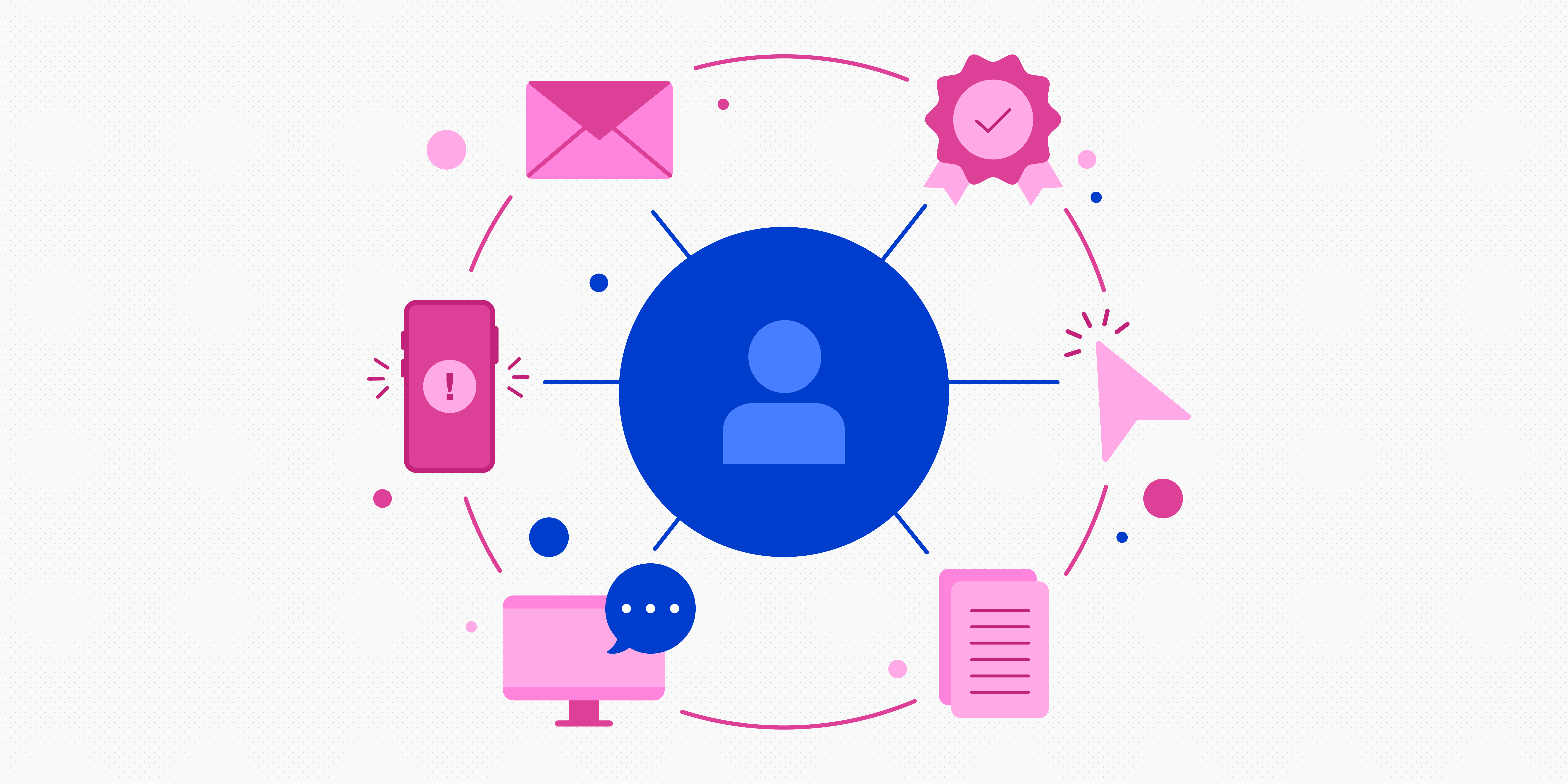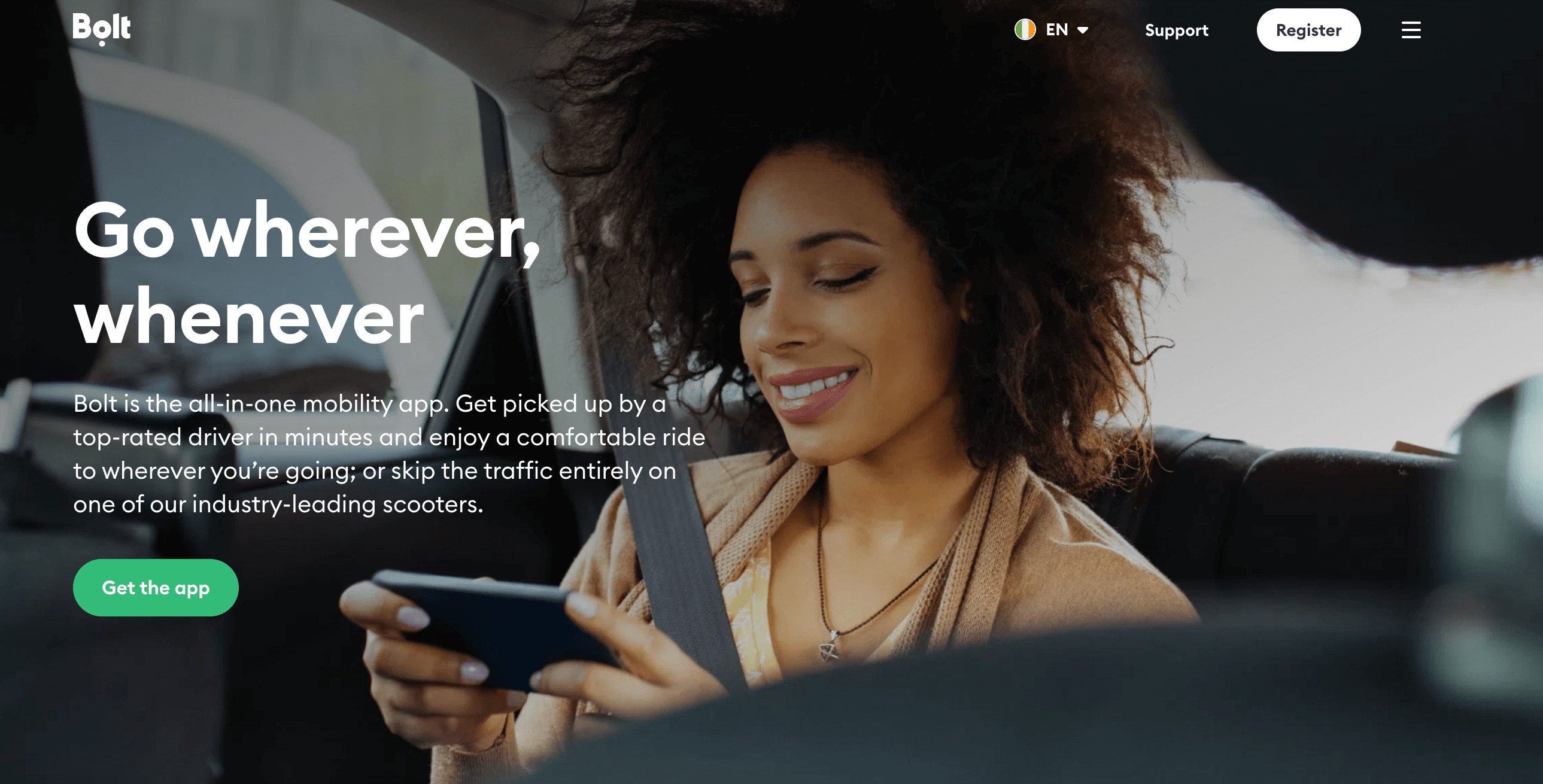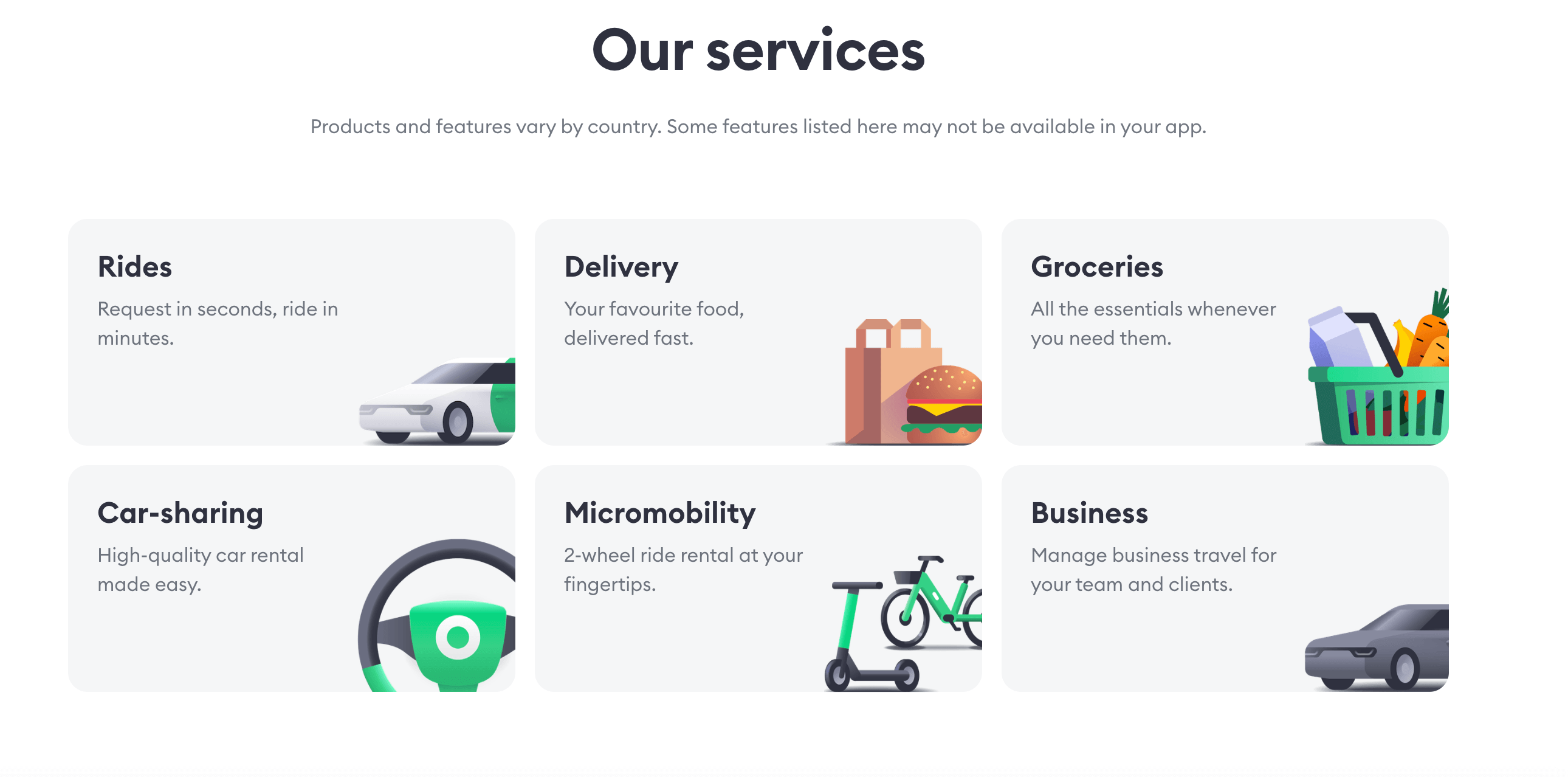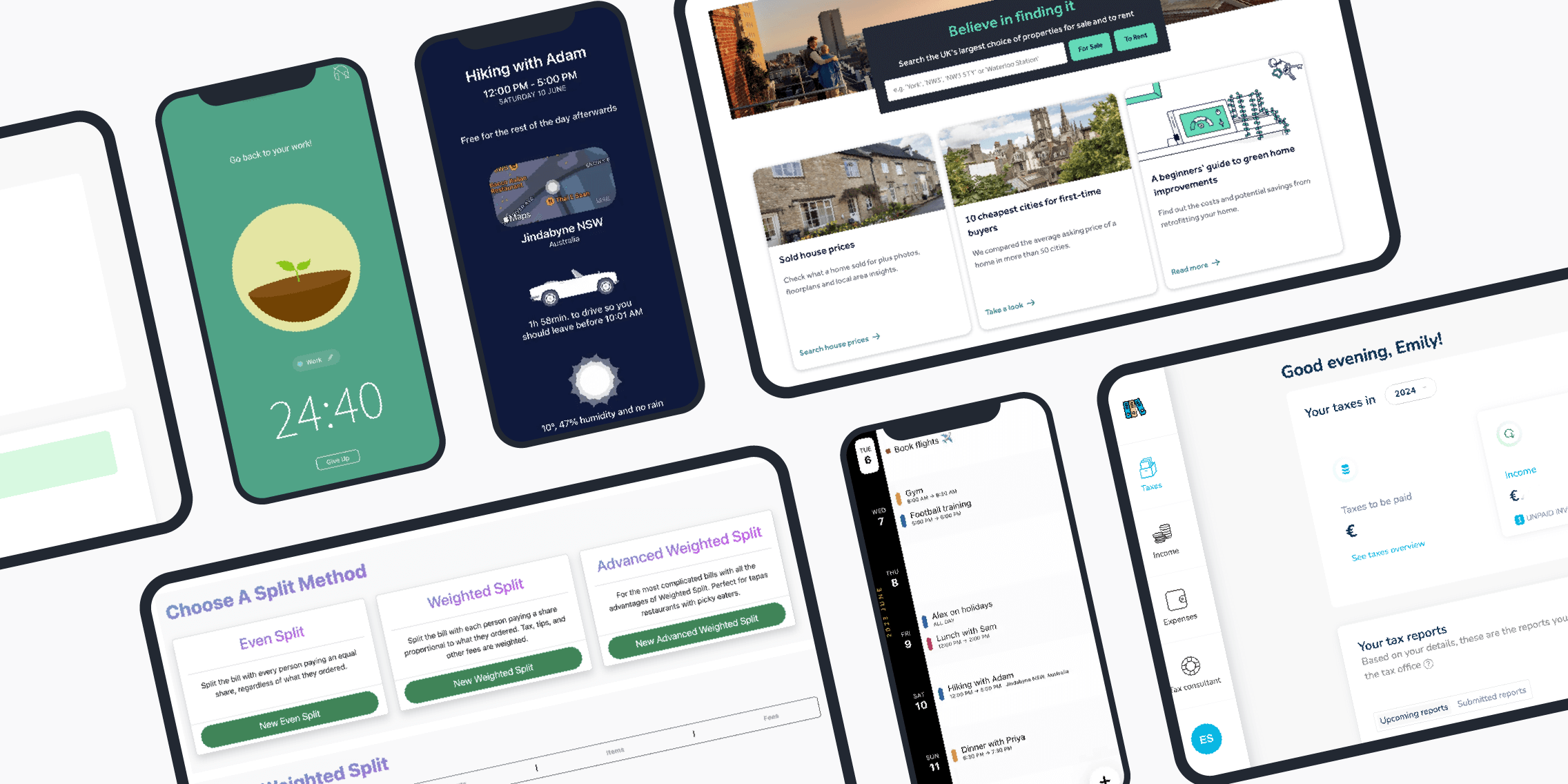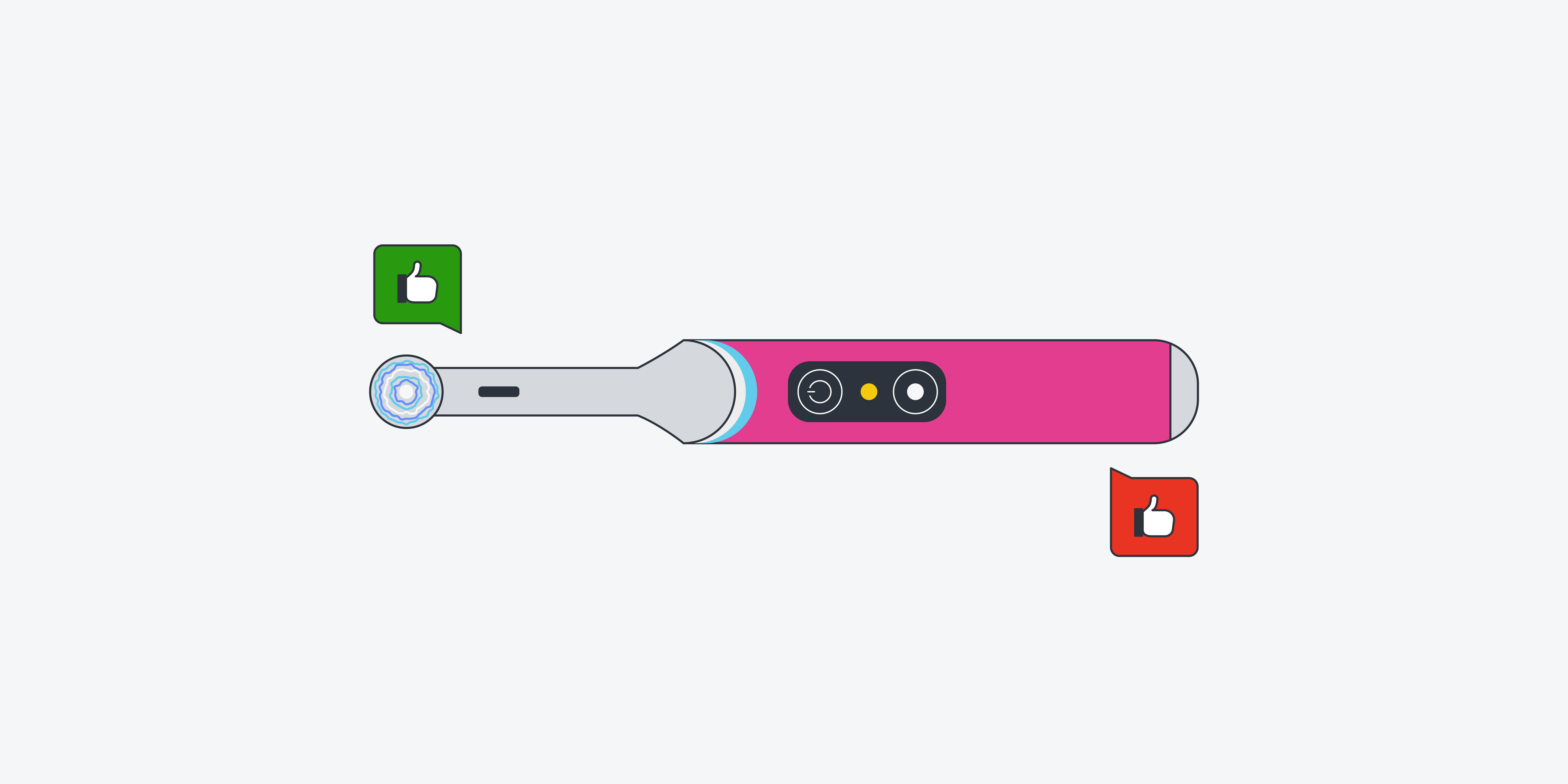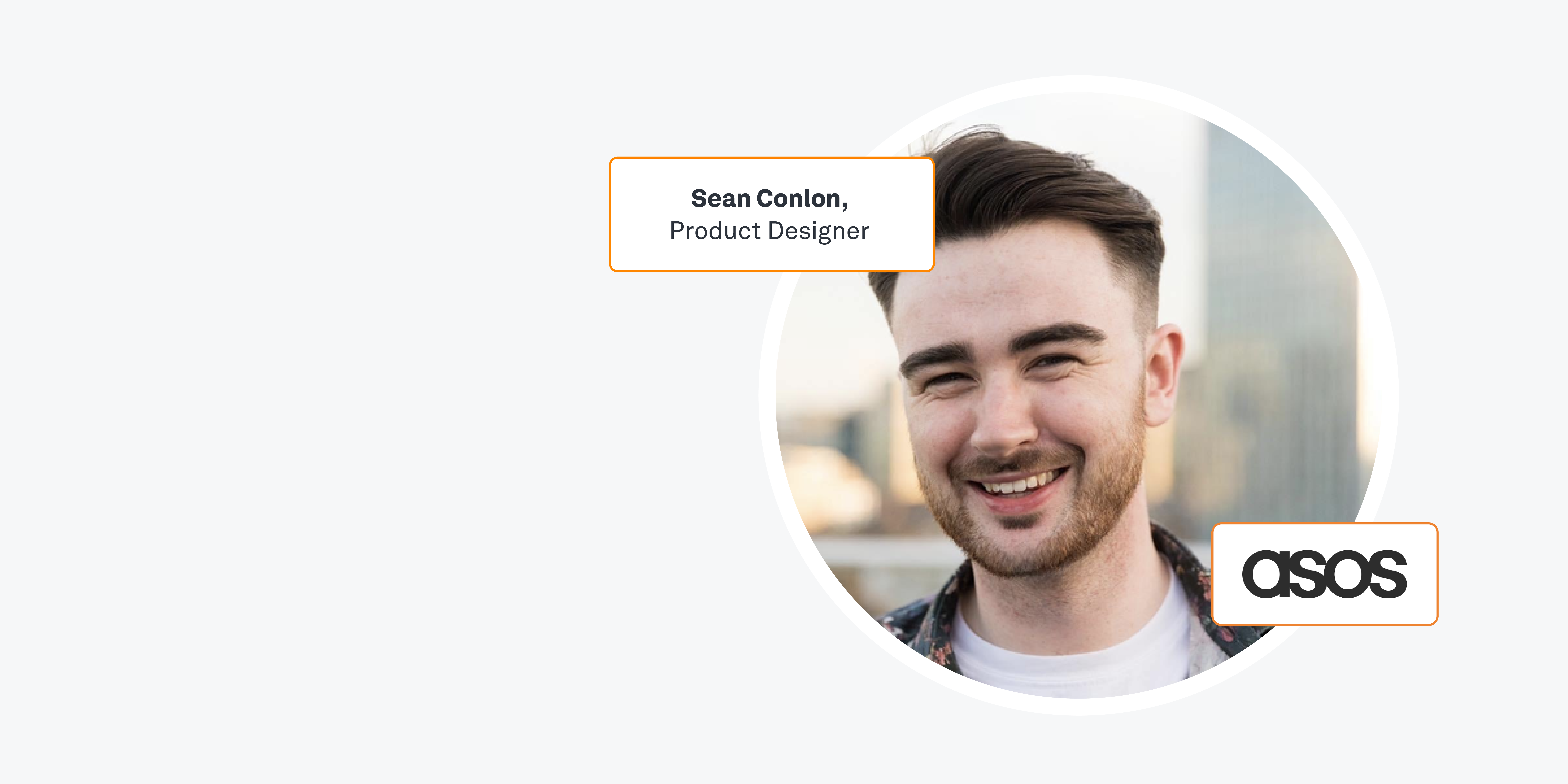We encounter service design everywhere in our daily lives — whether we are attending a gym class, buying train tickets online, or contacting customer service about a faulty product.
All of these individual processes, interactions, and touchpoints are part of an end-to-end service that has been carefully designed.
But what exactly is service design and why does it matter? What are the key principles and processes behind it?
Discover everything you need to know in this guide, complete with real-world examples.
What is service design?
Service design is all about optimising the quality and delivery of a service, both for the end user (the customer) and for the service providers.
A service is an intangible activity (or set of activities) designed to solve a specific problem, fulfil a particular need, or provide some kind of value to the end user. Think about opening a bank account, ordering a taxi, or booking flights.
Using a service typically requires the customer to interact with a service provider — a real person (say, a customer support agent), a product or system (e.g. an app, software, or chatbot), or both.
Service design considers the end-to-end experience that makes up a particular service. It’s not just a case of designing the service itself; it’s much broader and holistic, considering all the moving parts involved — not only on the customer-facing side but also behind the scenes at the company.
We can liken service design to a theatre production. If you were putting on a theatre play, you’d want to provide a brilliant show for your audience (the end users).
To do that, you’d have to consider not only the quality of the play itself but any additional factors that contribute to the theatre-goer’s experience — like the process of purchasing tickets, as well as the comfort and accessibility of the venue.
At the same time, you’d need to think about how to optimise operations backstage. You’d want to ensure that the actors, makeup artists, and sound and lighting engineers have everything they need for the show to run smoothly.
By considering all the moving parts, you can ensure that all key players work in harmony — resulting in a successful theatre production for everybody involved.
That’s exactly how service design works. In the case of everyday services, the actors and backstage technicians are the service providers — the companies and employees who deliver the service. The theatre-goers are the customers; who use the product or service and expect a great experience.
That’s service design in a nutshell. Before we dive deeper into service design, let’s first clarify how it differs from another design discipline: UX.
UX design vs. service design — what’s the difference?
Both UX design and service design are highly user-centric, and they both aim to provide a top-quality experience for the customer. However, they differ in terms of focus, scope, and methods.
UX design focuses primarily on improving a user’s experience with a particular product (often a digital product like an app or a website). It considers the usability and accessibility of the product itself, as well as the context in which a person might interact with the product.
Service design, on the other hand, considers the entire experience surrounding a service — not just from the user’s perspective, but also from the perspective of those who provide the service (e.g. employees at a company).
Let’s take the example of Bolt, an all-in-one mobility app. Through the Bolt app, users can book a taxi, order food and groceries, rent a scooter or a car, and arrange business travel for employees or clients.
Drivers, restaurant owners, and couriers can also use the Bolt app to promote their services and earn money.
In this example, a UX designer would be responsible for ensuring a positive user experience with the Bolt app itself. They would consider the layout and structure of the app, the information architecture, and the general accessibility, usability, and user-friendliness.
A service designer would zoom out and take a holistic view of the entire Bolt ecosystem. This would include user-facing products like the Bolt app and website, but it would also extend to other aspects of the experience — such as customer support, payments, internal company processes, and logistics.
And, while a UX designer would consider the Bolt product and experience from the end-user’s perspective, a service designer would think about all people and perspectives involved: customers, drivers, couriers, restaurant owners, and Bolt employees (e.g. customer service reps, sales staff, engineers, and so on).
In short: UX design focuses on the end user’s experience with a specific product. Service design takes a more holistic view, considering all interactions, processes, and touchpoints to ensure they work together seamlessly.
We’ll share some more real-world examples later on in our guide. For now, let’s consider the most important components and principles of service design.
The 3 components of service design
There are three core components of service design: people, props, and processes. A service designer considers how these three elements work together to ensure a seamless, effective, and cohesive service experience.
People
The first pillar in the service design triad is people. This concerns anybody and everybody who is involved in the service in some way — be that a customer who uses the service, employees who interact directly with customers, or employees who work behind the scenes.
The ‘people’ aspect of service design is all about creating meaningful and efficient interactions between all key players — by streamlining the customer service process, for example, or by enhancing cross-team collaboration internally.
Props
Remember our theatre analogy from earlier? Well, just like a great theatre production, an effective service requires a range of ‘props’.
This includes all tools, systems, and materials that are necessary for delivering the service — such as digital apps and software, or physical equipment and technology (e.g. an in-store kiosk).
Service designers consider what props are needed, and make sure that all tools and systems are reliable, easy to use, and contribute positively to the overall service experience.
Processes
The third pillar considers processes: all the workflows, policies, and practices that shape how the service is delivered or experienced.
This aspect of service design focuses on internal or behind-the-scenes operations, ensuring that employees are able to do their jobs effectively. It also considers the various processes a user or customer might go through as part of the service — say, signing up for a membership or booking tickets.
All together, these three pillars — people, props, and processes — form the foundation of service design.
5 fundamental principles of service design
In their book, This is Service Design Thinking, Marc Stickdorn and Jacob Schneider outline five fundamental service design principles:
1. User-centricity
Service design puts the end user at the heart of the process. Every aspect of the service should be developed with a deep understanding of the user’s needs, goals, and pain-points — usually gathered through continuous research and testing.
2. A co-creative approach
This principle emphasises the importance of involving all key stakeholders in the service design process — including end users, employees, and behind-the-scenes actors. By leveraging multiple perspectives, designers can create a well-rounded service that addresses different needs and challenges.
3. Sequencing
Sequencing involves breaking a complex service down into more manageable units. Each unit or sequence represents a certain stage in the customer’s journey, considering the user’s experience before, during, and after the service.
Sequencing helps to visualise the different moments and touchpoints that make up the user experience — and to identify and eliminate any unnecessary or frustrating steps.
4. Evidencing
Evidencing is all about providing physical or visual cues that make an otherwise intangible service feel real and trustworthy. If you’re booking flights, for example, a key part of that service involves receiving a confirmation email and a digital boarding pass.
This helps to build trust, guide the user through the service, and reassure them that the service is being delivered as promised.
5. A holistic view
This final principle stipulates that the service should be viewed as a whole. Rather than focusing solely on the end user’s perspective, service design should consider both ‘frontstage’ (what the customer sees) and ‘backstage’ (what employees do behind the scenes) to ensure that all moving parts work seamlessly together.
By keeping these principles in mind, you can create consistent, high-quality experiences that deliver real value to the end user — and optimise your internal capabilities and resources.
Why does service design matter? The importance and benefits
If you’re providing any kind of service, it’s essential that you’re thinking about service design. Service design not only ensures that you’re meeting your customers’ needs and driving end-user satisfaction; it’s also critical for operational efficiency.
Service design helps to:
- Boost customer satisfaction and loyalty. Service design focuses on meeting end-user needs and delivering high-quality experiences. This creates satisfied customers who are more likely to return — and recommend your service to others.
- Ensure a competitive advantage. In a crowded market, an exceptionally designed service will help you stand out from competitors, provide a memorable experience, and establish a strong brand reputation.
- Improve operational efficiency. By streamlining internal processes and making sure that frontstage and backstage operations are aligned, service design helps to ensure faster, more efficient service delivery — and a better experience for employees and stakeholders, too.
- Foster innovation and adaptability. The iterative nature of service design encourages service providers to respond quickly to market demands, trends, and customer feedback. This promotes constant innovation and adaptability, helping businesses and brands stay relevant and competitive.
- Drive revenue and cut costs. Service design is ultimately about boosting organisational efficiency and creating a seamless service experience. This helps to increase customer conversion rates and reduce costs — a big win for the bottom line.
So far, we’ve explored what service design is, the fundamental principles that underpin it, and why it matters. Now let’s consider what service design looks like in action.
A practical guide to the service design process
Whether you’re improving an existing service or creating a brand new one, the service design process will ensure that you’re focusing on your target users and optimising internal operations.
So how do you ‘do’ service design? Let’s take a look.
1. Conduct research to understand end users and stakeholders
Like any design challenge, you first need to understand who you’re designing for and why.
At this stage, your goal is to identify your target audience and determine their needs, expectations, objectives, and pain-points.
This includes:
- Conducting user research, using methods such as user interviews, surveys, focus groups, and ethnographic studies.
- Meeting with employees and internal stakeholders to understand their role, needs, and goals when delivering the service.
- Conducting competitor research and analysis to identify gaps and opportunities in the market.
- Creating user personas to capture the goals, challenges, and expectations of different customer segments.
By the end of the research phase, you should have a clear understanding of the people who will use your service, and what problem(s) they need your service to solve.
2. Ideate and develop service concepts
Next, you’re going to brainstorm potential solutions. Bearing in mind the fundamental principles of service design, this step should be user-centric and co-creative.
Leverage a diverse range of perspectives — including designers, customer service reps, managers, and stakeholders — as well as the customer insights you gathered during the research phase, to:
- Hold ideation workshops and brainstorming sessions. Use techniques such as mind mapping, sketching, and “How might we” exercises to spark ideas and get people thinking outside the box.
- Create user journey maps to visualise each idea / concept, considering the various channels, touchpoints, and actions the user will encounter along the way.
- Evaluate and prioritise ideas based on feasibility, potential impact, and alignment with user needs.
After brainstorming and prioritising, you should have one or two high-potential ideas that you want to explore and develop further.
3. Create a journey map and service blueprint
Next, you’re going to visualise how your service will look. This involves:
- Creating a journey map that breaks the service down into stages. Think back to the sequencing principle and consider the customer’s journey in terms of pre-service, during, and post-service, identifying important touchpoints at each step.
- Creating a service blueprint that captures frontstage interactions (i.e. what the customer does) and backstage processes (i.e. what happens behind the scenes). Include all relevant departments and stakeholders, and highlight potential bottlenecks. To help with this stage, consider using a service blueprint template — like this service blueprint template from Miro or this Figma template.
- Identifying gaps and pain-points within your blueprint so far. Consider specific areas or moments where users might experience frustration, or where internal delays may occur.
Mapping the service out visually in this way gives you a holistic view of how the service should work, both on the customer side and internally. This enables you to streamline collaboration and address any potential points of friction before you build the service and roll it out.
4. Prototype and test
In UX and product design, it’s best practice to prototype products and features before having them developed — and the same applies to service design. Here’s how to prototype and test for an intangible service:
- Determine exactly what elements and components of the service you’re going to prototype and test, referring back to your journey maps and blueprint from the previous step. You might prototype a customer support flow, a website checkout page, or the layout for a physical space. Consider the evidencing principle here and think about visual cues that can guide the user through the service.
- Create prototypes for each component. Prototypes can take the form of low-fidelity wireframes, physical paper mock-ups, high-fidelity digital prototypes, or role-playing scenarios — anything that enables you to visualise, convey, or live out the aspect(s) of the service you want to test.
- Test your prototypes on people who represent your target users (if you’re testing something for customers) and with employees (if you’re testing an aspect of the service that involves behind-the-scenes stakeholders). Observe, ask questions, and gather as much feedback and insight as you can.
The prototyping and testing phase enables you to highlight any gaps, pain-points, and usability issues within your service. Based on these insights, make changes and improvements before ‘going live’.
5. Roll out the service
After extensive planning, designing, prototyping, and testing, you’re ready to roll out your service (or new service feature). Depending on the complexity and scope, the roll-out phase may take weeks or months, and you might do it gradually in phases.
Here’s how to launch your new service or service feature:
- Create a detailed implementation plan. Break it down into actionable steps, assign specific tasks and responsibilities to relevant teams and stakeholders, and set deadlines. Work collaboratively to ensure that everyone understands their role in delivering the service.
- Make sure everybody has the tools, resources, and training necessary to deliver the new or updated service.
- Coordinate with sales and marketing teams to discuss how the new service (or service update) will be communicated to customers / end users, ensuring that marketing activities align with your planned implementation.
This is the stage in the service design process where all the moving parts come together. Be prepared to adapt and regroup as bottlenecks and friction points come to light.
6. Continuously test and iterate
Just like a tangible product, you want to make sure that your service consistently meets your end users’ needs and delivers value. As such, service design is an ongoing process, requiring continuous testing and iteration.
Once you’ve launched your new service (or updated it), you’ll want to:
- Track performance metrics such as customer satisfaction score, service efficiency, average resolution time and first response time (especially important for customer service), and conversion rates — to name just a few. Determine which metrics make sense for your service and continuously monitor success.
- Gather feedback from end users and internal stakeholders (remember that service design considers the service experience from all perspectives, not just that of your customers). Conduct regular surveys, interviews, and tests to identify areas for improvement.
- Based on the feedback and insights you gather, make incremental improvements to the service. This might include streamlining internal processes, adding or removing customer touchpoints, or implementing new tools — anything that improves the service experience in some way.
That’s the service design process in action. Now let’s take everything we’ve learned about service design and consider how it applies to some familiar real-world services.
Service design examples
1. IKEA Kitchen Planner service
Designing and building a whole new kitchen can be incredibly stressful — not to mention complex and time-consuming. To take the pain out of the process, IKEA offers a complete Kitchen Planner service.
Customers can use the interactive Kitchen Planner tool to input their kitchen’s dimensions and visualise their ideal kitchen setup. Alternatively, they can consult with an expert online or in-store.
Once they’re happy with the design, they can order all the necessary fixtures and components from IKEA and even book someone to come and install the new kitchen.
If you think about all the people, props, and processes that go into this service — and how they all work together to provide a seamless experience — you can see what good service design looks like in action.
2. Ryanair flight booking and check-in
Booking flights with an airline like Ryanair is another classic example of service design in action.
You might use the website or app to find and book flights, followed by confirmation of your booking via email. Once you’ve checked in, you get a digital boarding pass which you can access via the app (that’s a great example of the evidencing principle).
On the day of your flight, you go to the designated Ryanair check-in desk to drop off your luggage. During the flight, you might order drinks and snacks from the Ryanair catalogue.
Each and every moment in your journey is the result of careful service design, with a variety of products, physical and digital touchpoints, and people working together seamlessly.
3. BetterHelp online therapy
BetterHelp is an online platform that connects people with licensed therapists via video, phone, and instant messaging. BetterHelp’s goal is to make therapy accessible and convenient for people who might find in-person sessions difficult or unaffordable.
There are two key end-user groups who the BetterHelp platform must cater for: service users — those who want to connect with a therapist — and the therapists themselves.
Then, of course, there are the people working behind the scenes: the customer support agents, the marketing experts, and the designers and engineers who manage the BetterHelp website and app.
The end-to-end BetterHelp service requires many different props, such as the BetterHelp website and app, an effective and reliable scheduling system, and video/messaging functionality.
Last but not least, there are multiple processes at play: new user onboarding, the therapist matching process, the session scheduling workflow, and session follow-ups (to name just a few).
The entire BetterHelp ecosystem relies on all the moving parts working in tandem — and that’s what effective service design is all about.
Service design in summary
Service design is a holistic process dedicated to creating new services and improving existing ones. It considers all the people, props, and processes involved in delivering a service, with the goal of ensuring a high-quality experience — both for customers and end users, and for those working behind the scenes.
If you’d like to learn more about design — be it for intangible services or digital and physical products — we can recommend the following:
Looking for a more formal design education? Learn fundamental design principles, processes, and tools with the UX Design Institute’s Product Design (UX/UI) Programme.
Over the course of 9 months (requiring around 5 hours of study per week), you’ll learn everything that goes into creating a successful product — starting with UX fundamentals like user research, analysis, and information architecture, before moving on to UI essentials such as layout, colour, and interactivity.
Whether you’re a design novice, a product manager, or a UX or UI designer looking to broaden your skill set; this all-encompassing course will equip you with the skills you need to thrive in today’s design industry. Visit the course page for more information, or book a call with an education advisor to discuss your next steps.


